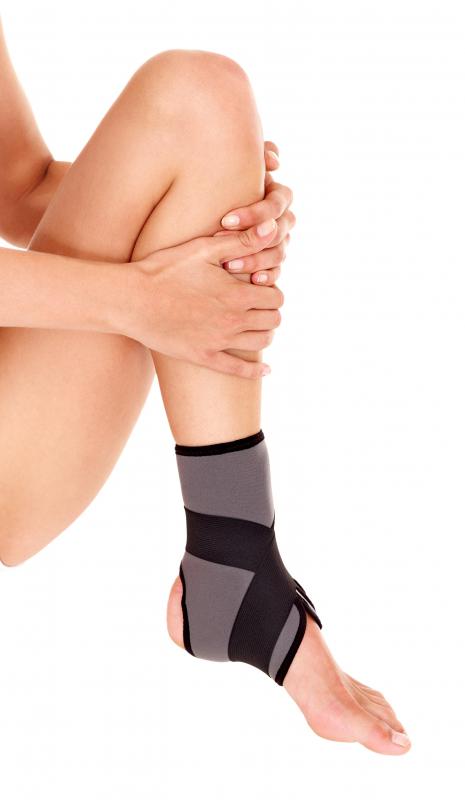At WiseGEEK, we're committed to delivering accurate, trustworthy information. Our expert-authored content is rigorously fact-checked and sourced from credible authorities. Discover how we uphold the highest standards in providing you with reliable knowledge.
What are Ankle Orthotics?
Ankle orthotics are external devices, usually in the form of shoe inserts or braces, designed to control the ankle. The most common ankle orthotic is called an AFO, or ankle-foot orthotic. These braces are designed to encompass the ankle and all or part of the foot to provide support and proper movement.
Ankle orthotics are used to control movement and provide stability to the ankle. They are useful in the correction or control of muscle imbalances and deformities. They directly control the ankle and can be used to indirectly control the knee by fixing problems. Ankle orthotics are used to hold the ankle and foot in position, and prevent things like drop foot and rolling of foot during ambulation.

Drop foot is the inability to dorisflex, or flex the foot up to clear the toes when walking. An AFO can maintain the foot at a ninety degree angle or more to eliminate tripping over the toes when swinging the leg forward. Pronation or supination, the rolling in or rolling out of the foot respectively, can cause pain in the ankle, legs and back. It can also cause instability which can lead to an increase in the risk of falls. An ankle orthotic can help control these abnormal movements and increase balance while decreasing pain symptoms associated with abnormal foot and ankle movement.

There are two types of ankle orthotics. The first is a brace that allows for normal ankle flexion, or bending of the ankle up towards the knee. This orthotic is for those individuals who have a minor deformity or problem and who are fairly active. A limiting ankle orthotic, on the other hand, totally limits the motion of the ankle and is commonly used for people who have severe deformities or chronic problems.

Ankle orthotics can be designed as shoe inserts, where either part of the foot or the entire foot is included. These plastic inserts go right into the shoe and allow for the ankle support necessary for proper movement. Other ankle orthotics consists of double upright metal bars attached directly to the outside of the shoe. There are even resting AFOs to maintain proper positioning while sleeping.

Most ankle orthotics are custom made. However, there are prefabricated AFOs designed to control foot drop. These are used primarily for training purposes. Many rehab centers use prefabricated orthotics to determine the need for customized versions. Some athletes also utilize prefab AFOs during training to teach the ankle proper positioning.
AS FEATURED ON:
AS FEATURED ON:















Discussion Comments
@talentryto- Your father is probably using the wrong typoe of ankle orthotic, and should check with an orthopedic specialist to make sure he gets the right kind for his problem. Otherwise, he may be doing more harm than good to his ankles.
My father has been using ankle orthotics, but is not getting any relief for his ankle pain. Does anyone have any thoughts about what may be causing his issues to continue?
Post your comments